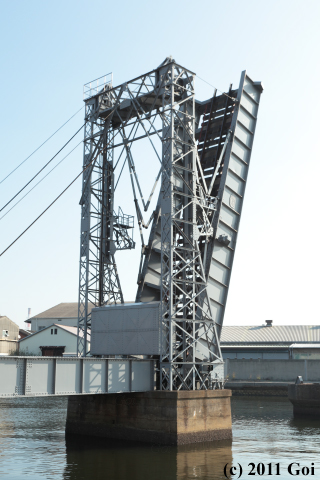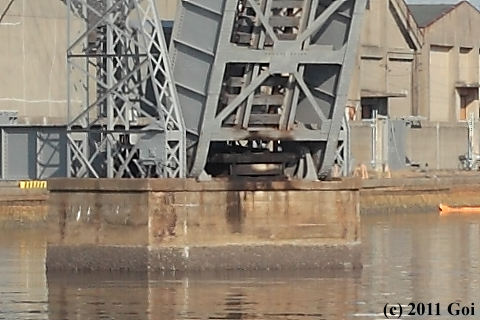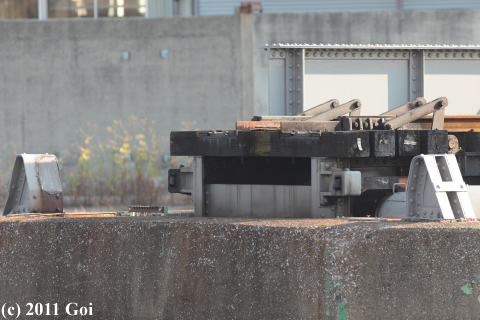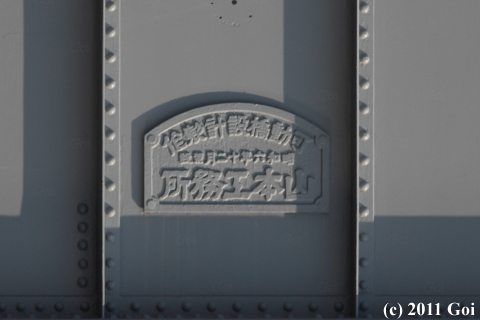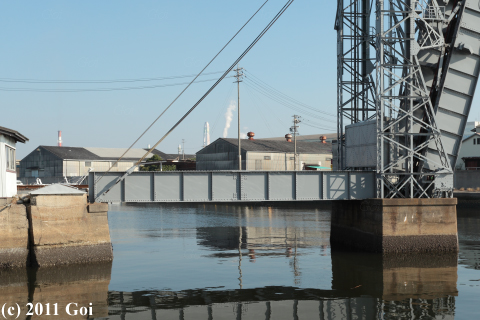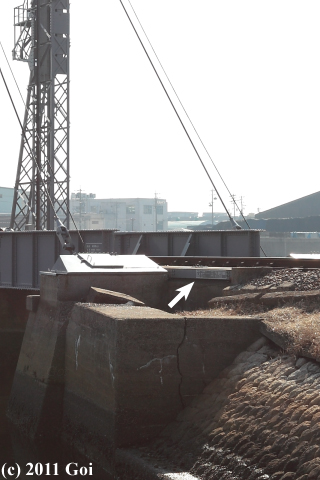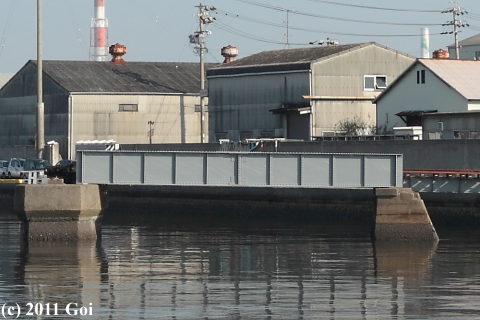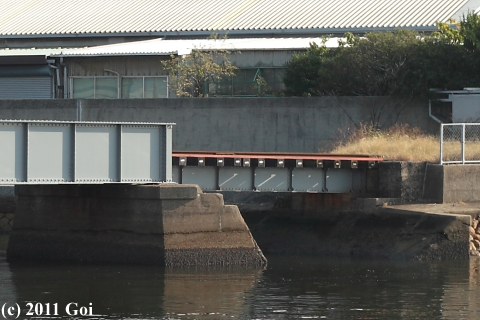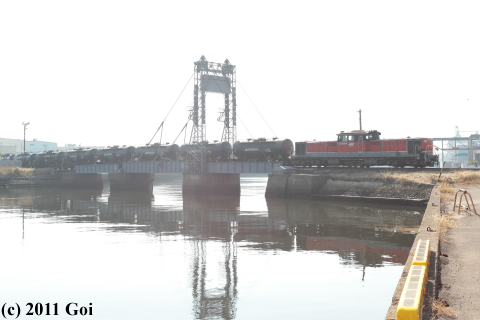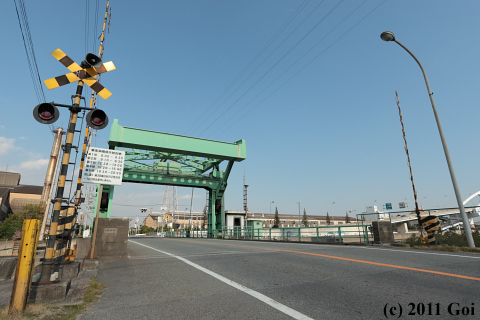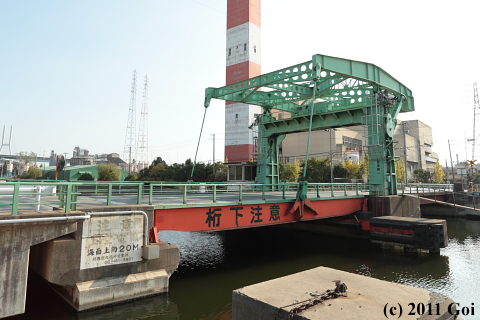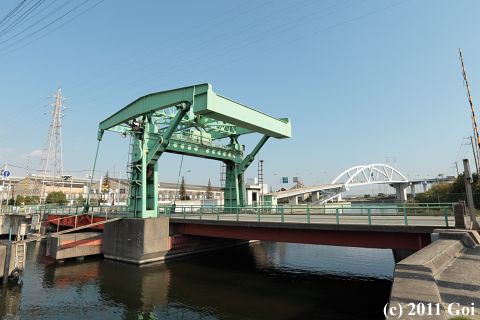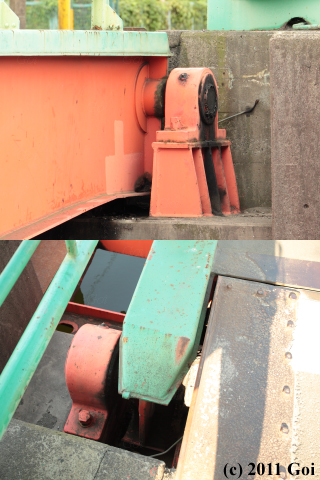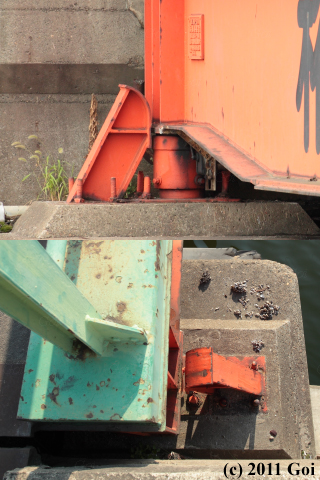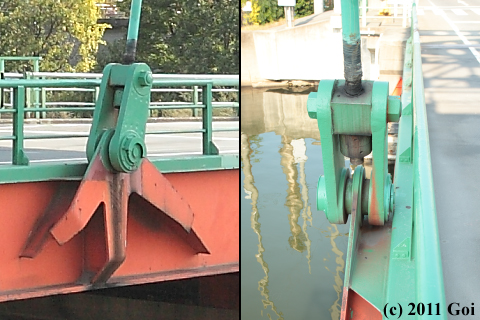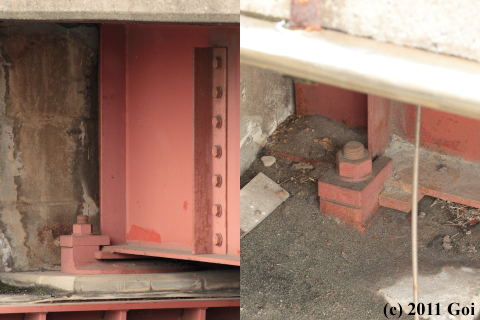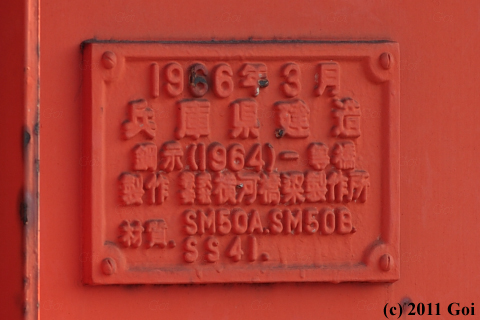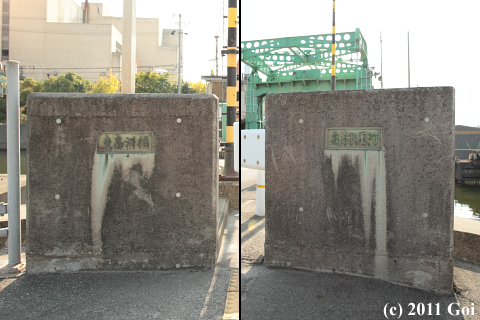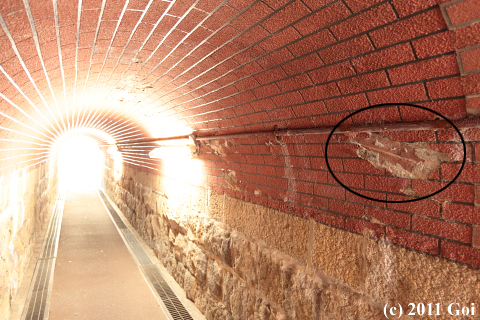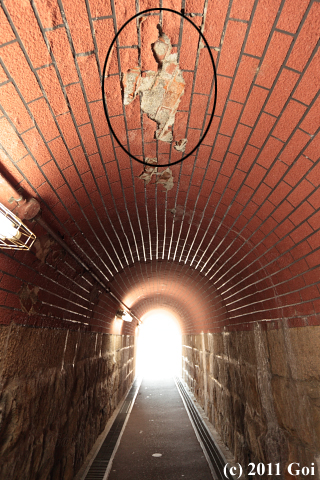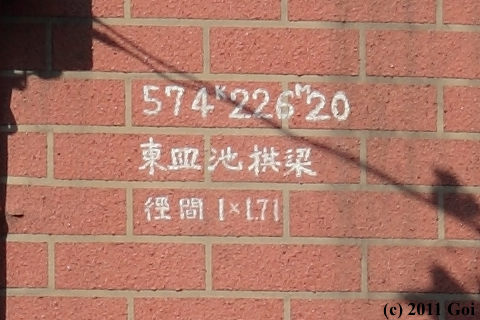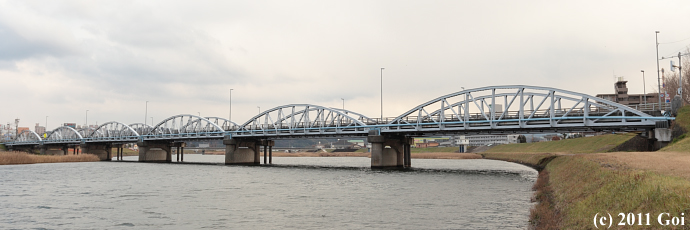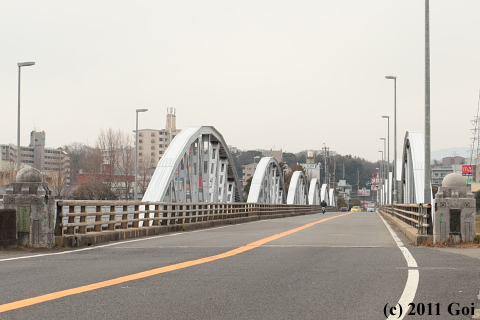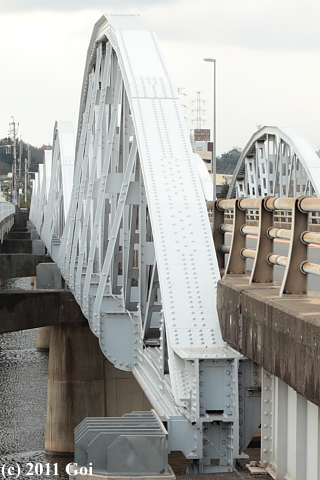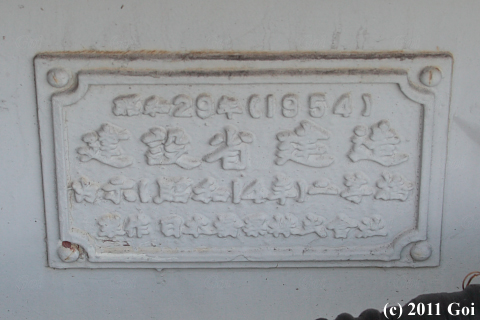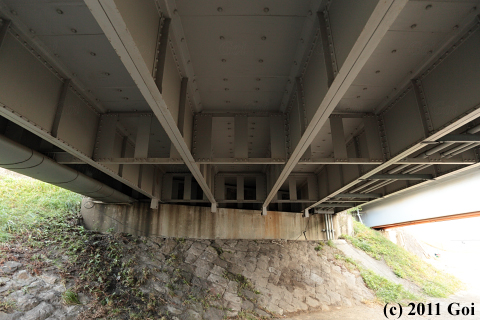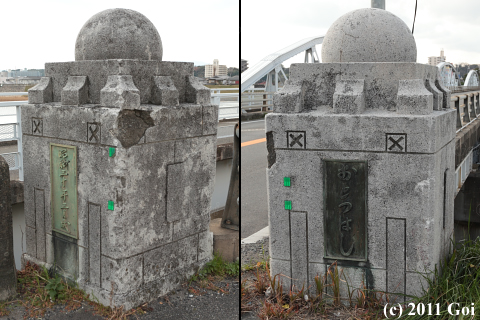末広 (すえひろ) 橋梁 :
Suehiro Bridge
千歳運河に、日本貨物鉄道 (JR貨物) の末広橋梁が架かっていました (34.95452, 136.63322) (2010年 秋)。
末広橋梁は5径間からなり、中央の径間の橋は跳開式の可動橋です。可動橋とその両側の径間の橋は鋼製の下路式プレート・ガーダー橋で、両端の径間の橋は鋼製の上路式プレート・ガーダー橋のようです。
左側の白い建物が操作室のようです。
Suehiro Bridge of Japan Freight Railway (JR Freight) spanned the Chitose Canal (34.95452, 136.63322) (
Autumn, 2010).
Suehiro Bridge is composed of five spans; the bridge of the span of the center is a movable bridge of draw types. The movable bridge, and the bridges of both side of that are seemingly plate girders which are made of steel of through types; the bridges of both ends are seemingly plate girders which are made of steel of deck types.
The house of the left side is seemingly the operation house.
西側の岸から見た可動橋です。
橋脚の上に、橋を引き上げるための塔が建てられています。
This is the movable bridge which was seen from the bank of the west side.
On a pier, the tower which draws up the bridge was built.
東側の岸から見た可動橋です。
塔は、西側の橋台へ碇着されているようです。
This is the movable bridge which was seen from the bank of the east side.
The tower is anchored on the abutment of the west side.
可動橋の支点となる支承部分です。
This is the bearing part as the fulcrum of the movable bridge.
可動橋の作用点側の支承部分です。
橋を導くためのガイドらしきものや、鎖錠装置なども設置されていました。
This is the bearing part of the load side of the movable bridge.
Seemingly guides which pilot the bridge, and locking systems etc. were put on also.
可動橋の銘板によると、橋は昭和6年 (1931年) に山本工務所が製作したようです。
塔の上部にも銘板があるようです。
According to the maker's plate on the movable bridge, the bridge was made by Yamamoto Kōmusho in 1931.
Also at the upper side of the tower, there was seemingly a maker's plate.
貨物線の起点である四日市駅側から数えて、2番目の径間の橋です。
2番目の径間の橋ですが、この橋の西端が載るのは、西側の橋台のようです。
The photograph is the bridge of the second span in the count from Yokkaichi Station side which is the starting point of the line.
Although this bridge is the bridge of the second span, the thing which put on the end of the west side of this bridge is seemingly the abutment of the west side.
矢印の橋が、1番目の径間の橋のようです。
この橋は西側の橋台の上に架かり、この橋の下に可動橋の引き上げ機械があるようです。
The thing which the arrow points is seemingly the bridge of the first span.
It seems that this bridge spans over the abutment of the west side, and the drawing machinery of the movable bridge is set under this bridge.
4番目の径間の橋と、橋脚です。
The photograph is the bridge of the fourth span, and piers.
5番目の径間の橋と、東側の橋台 (右) です。
The photograph is the bridge of the fifth span, and the abutment of the east side (
right).
5番目の径間の橋の垂直補剛材は、両端部がフランジへと湾曲した形のものでした。
The vertical stiffeners of the bridge of the fifth span were types of which both ends were bent to flange angles.
警報音が鳴り可動橋が降ろされると、貨車を牽いたJR貨物のDD51形ディーゼル機関車が橋をゆっくり通過していきました。
After an alarm went off and the movable bridge was gotten down, a diesel locomotive of the DD51-type of JR Freight which pull freight cars slowly went past the bridge.
末広橋梁は、国により重要文化財に指定されています。
Suehiro Bridge has been designated as an Important Cultural Properties by nation.
東高洲 (ひがしたかす) 橋 :
Higashitakasu Bridge
高洲運河に、東高洲橋が架かっていました (34.70498, 135.40948) (2010年 秋, 2011年 秋)。
東高洲橋は2径間からなり、北東側の径間の橋は跳開式の可動橋です。両径間の橋とも上路式ガーダー橋のようです。
Higashitakasu Bridge spanned the Takasu Canal (34.70498, 135.40948) (
Autumn, 2010, Autumn, 2011).
Higashitakasu Bridge is composed of two spans; the bridge of the span of the north-east side is a movable bridge of draw types. The each bridge of both spans is seemingly a girder bridge of deck types.
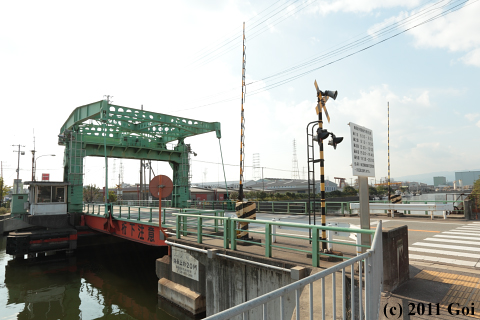
北東側の岸から見た橋です。
橋脚上の門状のものが跳開装置で、その左側の建物が操作室のようです。
橋は、決まった時間帯に、かつ、船舶が通行する場合にのみ、引き上げられるようです。「操作時刻表」に表示された時刻に近づくと、二人の操作係らしき人が自転車に乗って橋へやってきました。そして、操作室で操作時刻が過ぎるまで待機すると、ふたたび自転車に乗ってどこかへ去っていきました。
This is the bridge which was seen from the bank of the north-east side.
The thing which is such as a gate on the pier is the draw device; the house of the left side of that is seemingly the operation house.
Only when the set times and ships go through the bridge, the bridge is seemingly drawn up. When time approached a time which was signed on "Operation Timetable", two men which are seemingly the operators came to the bridge by bicycle. And operators stay in the operation house until the operation time passed, then they again ride on the bicycles and were going away.
南西側の岸から見た橋です。
橋の両端には、踏切にあるような遮断機がありました。
This is the bridge which was seen from the bank of the south-west side.
At both ends of the bridge, there were gates such as things which were put at railroad crossings.
可動橋が架かる北東側の橋台は、岸から独立していました。
The abutment of the north-east side which was spanned the movable bridge was independent from the bank.
南西側の径間です。
This is the span of the south-west side.
可動橋の支点となる支承です。
This is a bearing as the fulcrum of the movable bridge.
可動橋の作用点側の支承です。緩衝装置付かもしれません。
支承の傍には、橋を支承へ導くためのガイドらしきものが設置されていました。
This is a bearing of the load side of the movable bridge. It may be with a buffer.
Seemingly a guide which pilots the bridge to the bearings was put on the side of the bearing.
可動橋の力点となる部分です。
This is a part as the effort of the movable bridge.
南西側の径間に架かる橋の支承です。左が橋脚側の支承で、右が橋台側の支承です。
Those are bearings of the bridge which is spanned at the span of the south-west side. The left side of the photograph is a bearing of the pier side, and the right side is a bearing of an abutment side.
これは可動橋の銘板です。
可動橋の銘板によると、可動橋は昭和41年 (1966年) に兵庫県が建造し、製作は横河橋梁製作所によるようです。東高洲橋は、一等橋として架けられたようです。
This is the maker's plate of the movable bridge.
According to the maker's plate of the movable bridge, the movable bridge was constructed by Hyogo prefecture in 1966, and the bridge was made by Yokogawa Bridge Works. It seems that Higashitakasu Bridge has been constructed as first class.
これは南西側の径間に架かる橋の銘板です。
This is the maker's plate of the bridge which is spanned at the span of the south-west side.
北東側の親柱です。
These are the newels of the north-east side of the bridge.
南西側の親柱です。
These are the newels of the south-west side of the bridge.
東皿池 (ひがしさらいけ) 拱梁 :
Higashisaraike Bridge
西日本旅客鉄道 (JR西日本) の東海道線で、東皿池拱梁が架かっていました (34.73727, 135.32075) (2010年 秋)。
写真の上側が南側で、下側が北側です。
Higashisaraike Bridge spanned in the Tokaido Line of West Japan Railway (JR West) (34.73727, 135.32075) (
Autumn, 2010).
The upper side of the photograph is the south side, and the lower side is the north side.
Higashisaraike Bridge is composed of one span, and is a
*skew bridge to a left direction; it is seemingly a
*Nejirimanpo.
アーチの内側にはレンガ模様のシート状のものが貼られていましたが、そのシートが剥がれている部分に、斜めに積まれたらしきレンガが見えます。(写真は、南側から北側へ向けて撮影されています。)
On the inside of the arch, some kind of sheet of a brick pattern was pasted, but at the parts of the sheet which peeled, the seemingly askew piled bricks are looked. (The photograph was taken to the north side from the south side.)
拱頂の部分でも、レンガは斜めに並んでいるようです。(写真は、北側から南側へ向けて撮影されています。)
At also the top of the arch, the bricks are seemingly askew arranged. (The photograph was taken to the south side from the north side.)
南側のスパンドレルに、橋梁名などが書かれていました。
On the spandrel of the south side, the bridge name etc. were written.
乙津 (おとづ) 橋 :
Otozu Bridge
乙津川に、乙津橋が架かっていました (33.24099, 131.68062) (2010年 冬, 2011年 冬)。
乙津橋は7径間からなり、鋼製の下路式ポニー・ボーストリング・プラット・トラス橋が6径間で、上路式ガーダー橋が1径間で架けられていました。
Otozu Bridge spanned the Otozu River (33.24099, 131.68062) (
Winter, 2010, Winter, 2011).
Otozu Bridge is composed of seven spans; pony Pratt bowstring truss bridges which are made of steel of through types, were spanned at six spans; a girder bridge of deck types was spanned at one span.
トラス橋では下路式であっても横梁などがないために、トラス橋の径間でも開放感があります。
Because the truss bridges are through types but without upper beams etc. at the truss bridges, there is openness also at the truss bridge spans.
トラス橋には、ポニー形式のためと思われる垂直補剛材が設置されていました。
垂直補剛材は、各片側9本ある垂直材のうち、7本の外側に設置されていました。
At the truss bridges, pony types are probably the reason, vertical stiffeners were put on.
The vertical stiffeners were put on the outside of the seven vertical posts in which there are nine in each one side.

トラス橋の各銘板によると、西側 (左岸側) から4つは昭和26年 (1951年) に大分県が、東側 (右岸側) から2つは昭和29年 (1954年) に建設省が建造し、製作はすべて日本橋梁によるようです。
写真の上側が「大分縣建造」と標された銘板で、下側が「建設省建造」と標された銘板です。
乙津橋は、二等橋として架けられたようです。
According to the each maker's plates of the truss bridges; the four truss bridges from the west side (
the left bank side) were constructed by Oita prefecture in 1951, the two truss bridges from the east side (
the right bank side) were constructed by Ministry of Construction in 1954, and the all bridges were made by Japan Bridge.
The upper side of the photograph is a maker's plate which said "大分縣建造" (Construction of Oita prefecture), and the lower side is a maker's plate which said "建設省建造" (Construction of Ministry of Construction).
It seems that Otozu Bridge has been constructed as second class.
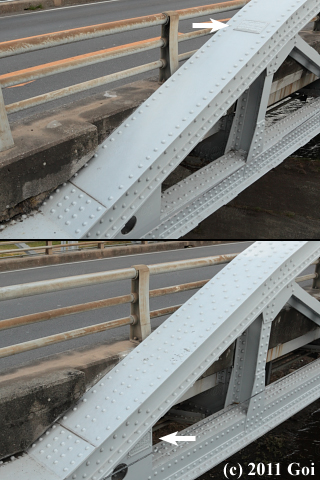
大分県が建造したトラス橋と、建設省が建造したトラス橋では、鋼材の種類や組み方が異なるのか、リベットの並び方などに異なる部分がありました。写真の上側は大分県が建造したもので、下側は建設省が建造したものです。
大分県が建造したトラス橋の銘板は上弦材の上面 (上側矢印) にありましたが、建設省が建造したトラス橋の銘板は上弦材と下弦材が結合されている部分 (下側矢印) にありました。建設省が建造したものでは、一般的な銘板の取り付け位置にはリベットが並ぶために、べつの位置に取り付けられたのかもしれません。
Because the types and the composing of the steel materials may be different, there are the different parts which are the arrangement of the rivets, etc., between the truss bridges which were constructed by Oita prefecture and the truss bridges which were constructed by Ministry of Construction. The upper side of the photograph is a thing which was constructed by Oita prefecture, and the lower side is a thing which was constructed by Ministry of Construction.
There were the maker's plates of the truss bridges which were made by Oita prefecture on the upper sides of the upper chord members (upper side arrow); but there were the maker's plates of the truss bridges which were made by Ministry of Construction on the parts where the upper chord member and the lower chord member were united (lower side arrow). In the truss bridges which were made by Ministry of Construction, it may be that because the rivets were arranged at the general positions where the maker's plates are put on, those were put on the other positions.

写真の上側は大分県が建造したもので、下側は建設省が建造したものです。
添接板にも差異がありました。
The upper side of the photograph is a truss bridge which was constructed by Oita prefecture, and the lower side is a truss bridge which was constructed by Ministry of Construction.
There were the differences also at the splice plates.
トラス橋の支承です。
写真の上側が固定支承で、下側 (手前) が可動支承 (ローラー支承) です。
These are the bearings of one truss bridge.
The upper side of the photograph is a fixed bearing; the lower side (this side) is an expansion bearing (roller bearings).
トラス橋の床版の裏側と、橋脚です。
This is the back of the slab of one truss bridge, and one pier.
橋の東端に架かるガーダー橋です。
This is the girder bridge which was spanned at the end of the east side of the bridge.
ガーダー橋の銘板です。
ガーダー橋は昭和29年 (1954年) に建設省が建造し、製作は日本橋梁によるようです。
This is the maker's plate on the girder bridge.
It seems that the girder bridge was constructed by Ministry of Construction in 1954, and it was made by Japan Bridge.
ガーダー橋の支承です。
写真の左側が可動支承で、右側が固定支承のようです。平面支承のようです。
These are the bearings of the girder bridge.
The left side of the photograph is seemingly an expansion bearing; the right side is seemingly a fixed bearing. The bearings seemingly are plane bearings.
ガーダー橋の床版の裏側と、橋台です。
ジベルらしきものがあるので、ガーダー橋は合成桁かもしれません。
This is the back of the slab of the girder bridge, and one abutment.
Because there are seemingly shear connectors, the girder bridge may be a composite girder bridge.
西側 (左岸側) の親柱です。
These are the newels of the west side (the left bank side) of the bridge.
東側 (右岸側) の親柱です。
大分県の資料によると、乙津橋の読みは「おとづはし」のようですが、親柱には「おとつはし」と標されていました。
乙津橋は、昭和30年 (1955年) 3月に完成したようです。
These are the newels of the east side (the right bank side) of the bridge.
According to data of Oita prefecture, the reading of Otozu Bridge is seemingly "Otozu Hashi", but in one newel, it said "Ototsu Hashi."
It seems that Otozu Bridge has been completed in March, 1955.
和田 (わだ) 旋回橋 :
Wada Revolving Bridge
兵庫運河に、西日本旅客鉄道 (JR西日本) の和田旋回橋が架かっていました (34.66025, 135.16712) (2010年 秋)。
和田旋回橋は2径間からなり、鋼製の上路式プレート・ガーダーが架けられていました。この橋は明治32年 (1899年) に開通し、以前は旋回式の可動橋だったようです。現在は、橋は橋台や橋脚に固定されて旋回しないようです。旋回のための機械装置もないようですが、橋脚の円周に沿ってレール状のものがありました。旋回のために使われていたものかもしれません。
Wada Revolving Bridge of West Japan Railway (JR West) spanned the Hyogo Canal (34.66025, 135.16712) (
Autumn, 2010).
Wada Revolving Bridge is composed of two spans; a plate girder which is made of steel of deck types was spanned. It seems that the bridge was opened in 1899; formerly, the bridge had been a movable bridge of revolving types. The now, the bridge was seemingly fixed to abutments and a pier, it cannot revolve. Also the rails on both ends of the bridge did not have a gap. The machinery for revolving does not seemingly exist; but there was a thing which is such as rails along the circle of the pier. It may be that the thing had been used to revolve.


